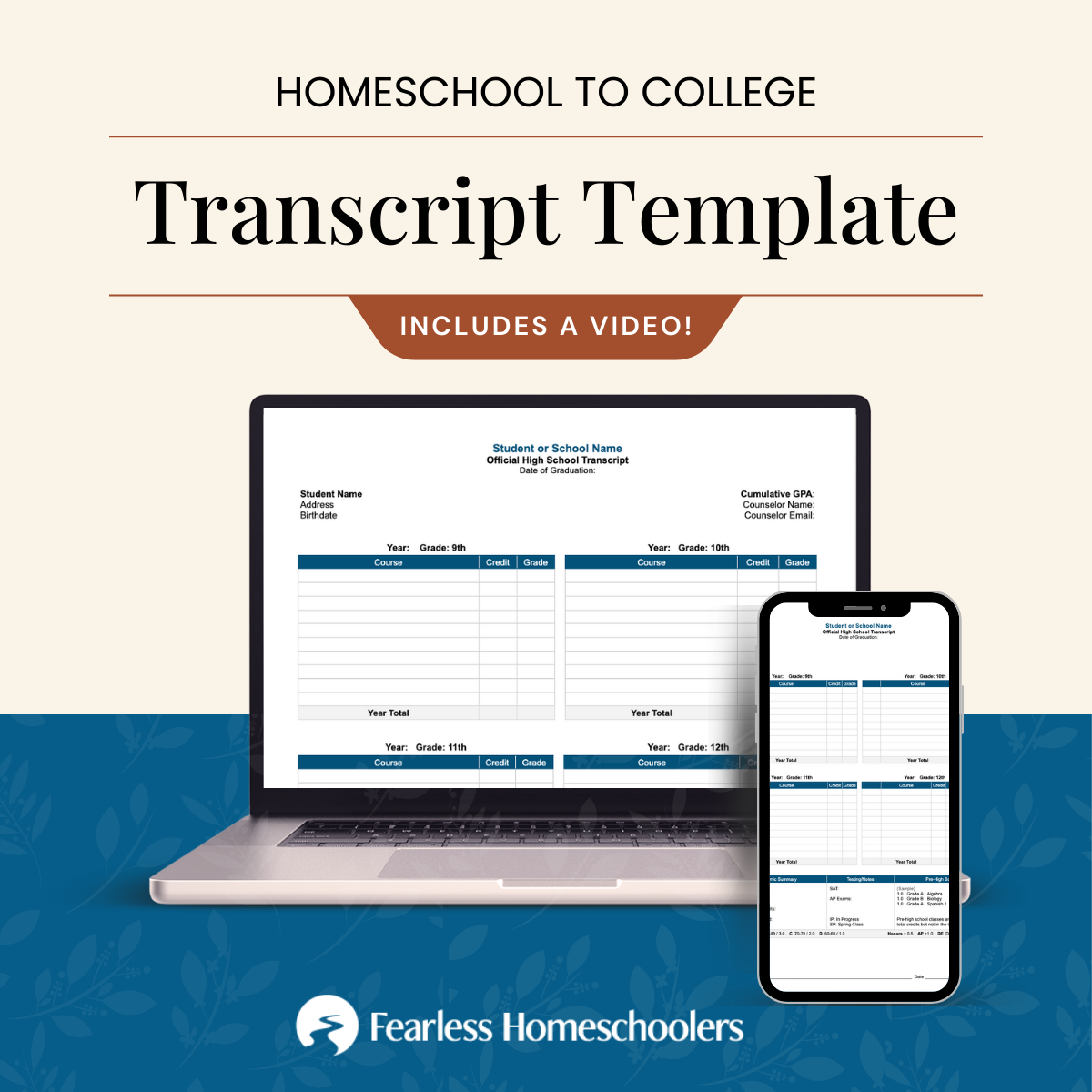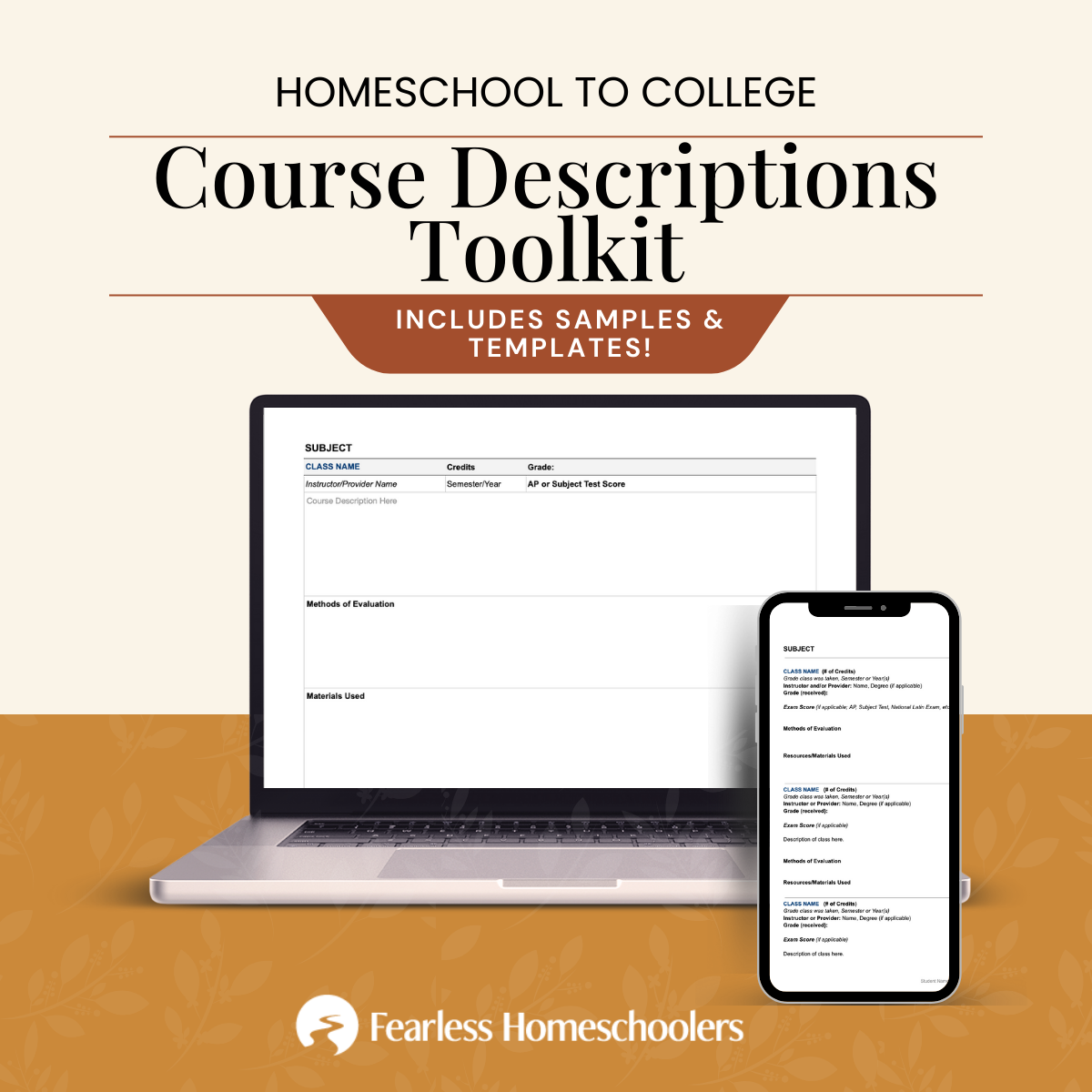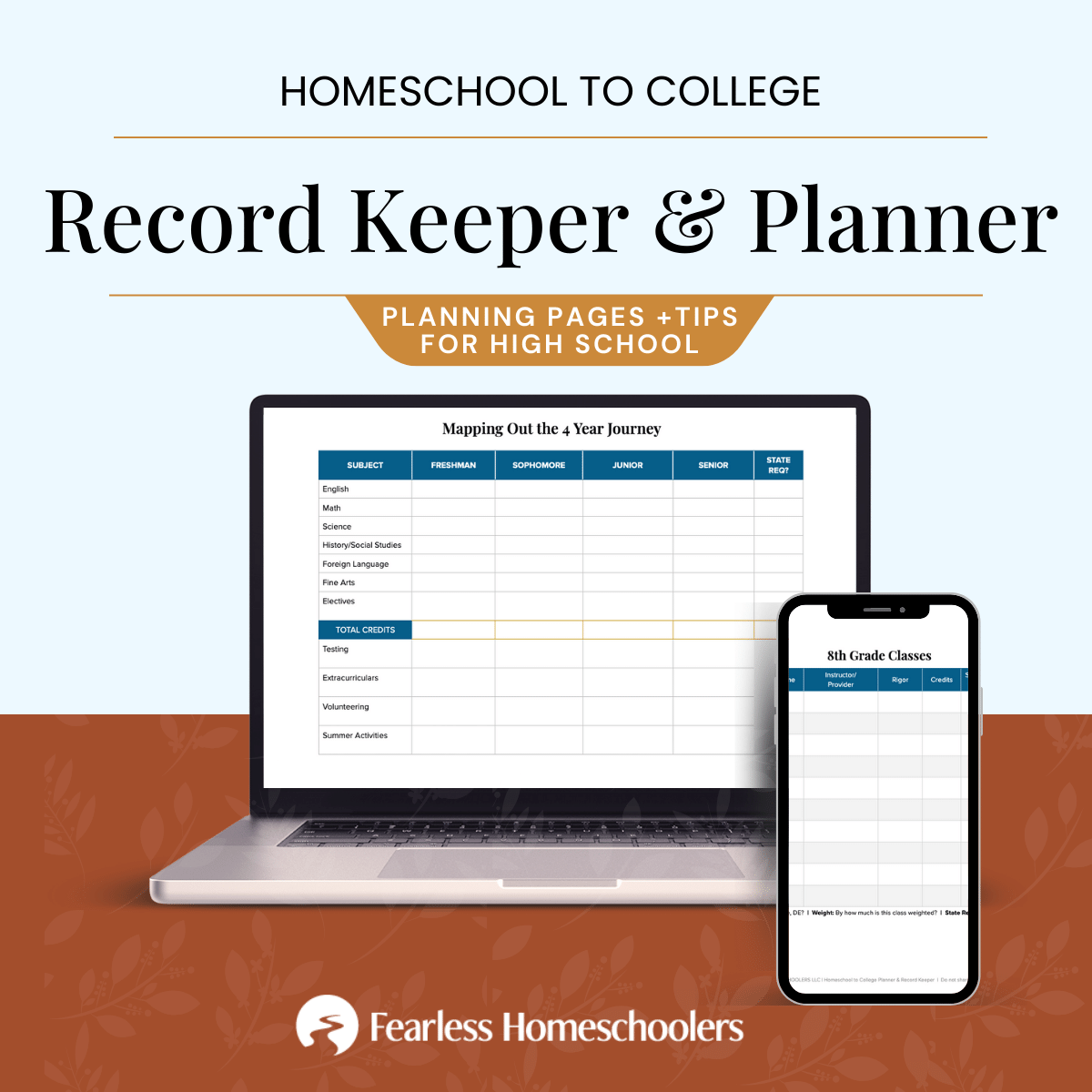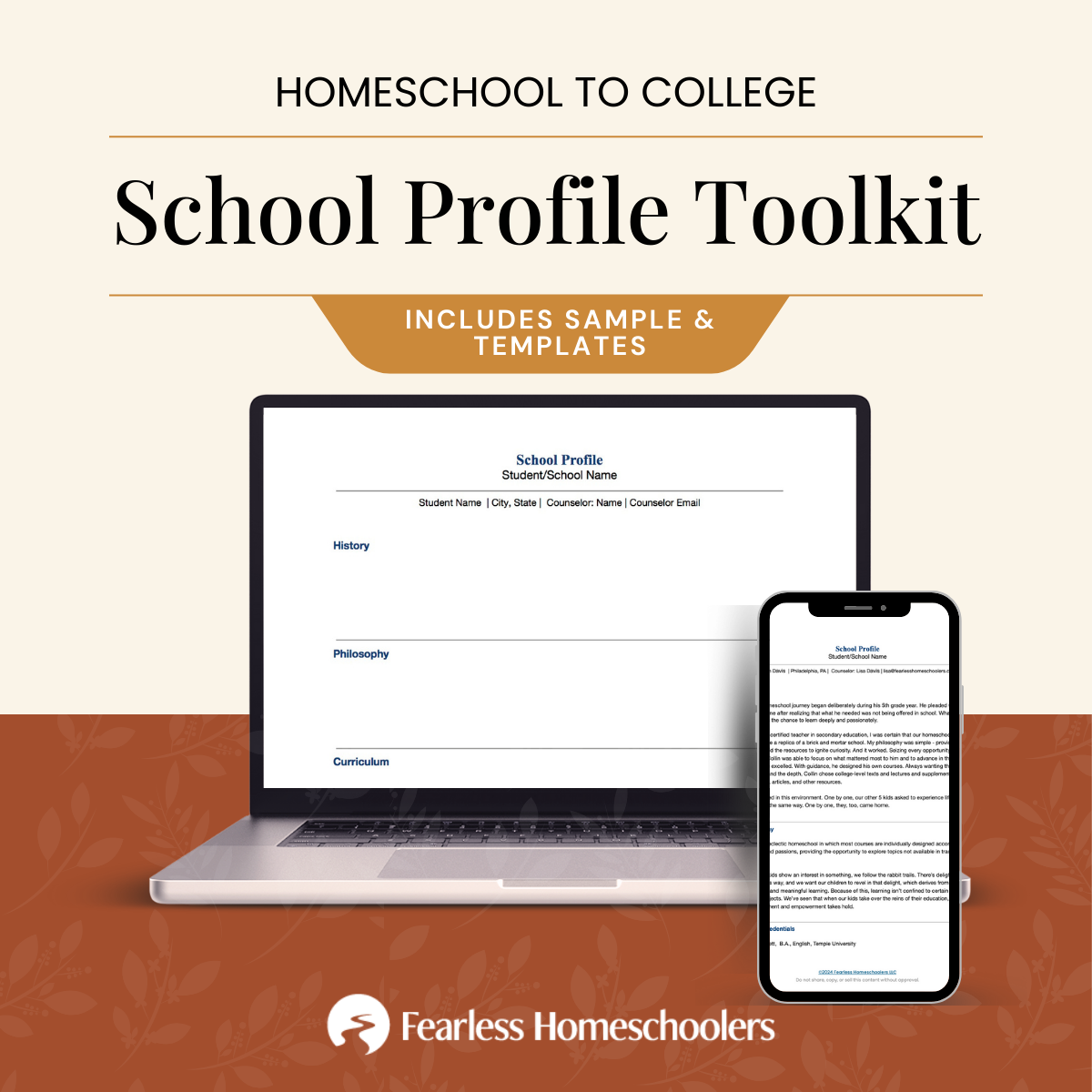Why Your Homeschool Transcript Should be Organized by Year
It never fails. I’m on a video call with a student, and I get overly enthusiastic about something. My pitch gets a bit higher, and my words get a bit faster. I start throwing around jargon like Common App, Demonstrated Interest, ED, DE, LOCI. Then I get the confused look.
I know it well. Even through Google Meet.
I start over, remembering to put myself in their shoes.
When it comes to the organization of your transcript, I ask you to do the same. Put yourself in the shoes of a college admissions officer.

As a veteran homeschooler, I know how natural it is to look at things as a homeschool parent in charge of providing evidence of your teen’s rigorous high school.
But now, as a college admissions consultant who talks regularly with admissions reps? I see things through their lens, too.
In this article, we’ll chat about homeschool transcript templates and their formats. Which is better: a transcript organized by subject or date?
Inside this article, we’ll cover:
- Subject vs Yearly Homeschool Transcript: Which Template is Better?
- Why Homeschoolers Like Subject Transcripts
- The Advantages of Transcripts Organized by Date
- Why Colleges Prefer Yearly Transcripts
- Questions and Answers About Organizing Your Yearly Transcript
Subject vs. Yearly Homeschool Transcripts
When it comes to transcripts, homeschoolers tend to organize them in two ways: by subject or by year.
- A subject transcript groups all courses taken in a particular subject together.
- A yearly transcript groups all courses taken in a particular year together.
At first glance, they might look similar: both are a one-page transcript filled with classes, grades, credits, and GPA. Both tell the story of a teen’s high school years.
But, if you hang out in homeschool circles, many parents believe a subject transcript tells the story better.
Why Homeschoolers Like Transcripts Organized by Subject
One obvious benefit to homeschooling high school is flexibility. Classes and subjects aren’t necessarily confined to a particular year any more than they’re confined to inside the home.
- It’s common to take a course in the summer.
- Or continue a course throughout the summer.
- Or begin a course in the summer.
The lines are blurred. The learning doesn’t end.
Listing classes without specific dates is the most common reason for organizing by subject. A win-win many would say.
And what about the teen enamored with a particular subject?
Indeed, a subject transcript showcases that passion perfectly when all lumped together.
But, if you put yourself in an admission officer’s shoes, you might see things differently.
Know Your Audience
I know you’ve taught your kids this! When writing something, anything, it’s important to write for your particular reader. Use your own advice and create a transcript for your audience.
And just who is the typical college admissions officer? Young! In their twenties. Not much older than your high schooler!
So what does that generation prefer? Scannability. Quick. Easy.
👉 Get Your Homeschool Transcript Template HERE!
Here’s the Other Problem
These admissions officers spend months in what is known as the Reading Season. They read dozens of applications a day.
Imagine you’re a young admissions officer. You’re on the 20th application of the day. Your eyes are glazing over.
You have 10-20 minutes to read an entire college application from an applicant: essays, letters of recommendation, activities list, course descriptions, school profile, counselor letter, and…the transcript.
The transcript will be the first thing you look at (beyond the demographic info in the application). You scan the transcript quickly and take note of the context. Where is the student from? What school do they attend? What kinds of grades and rigor did they start with in 9th grade? How do the grades and rigor look now in 11th and 12th?
If you haven’t yet read my article, Three Things Colleges Want on Your Homeschool Transcript, you should. In it, I talk about the importance of the Upward Trend that admissions officers want to see. Can they easily see an improvement in grades and an increase in rigor over the four years of high school? Or do they have to work hard to make sense of it all?
Let’s take a look at examples. Here’s a well-loved hybrid subject/date transcript template (in homeschool circles) and a yearly transcript template side by side. Which one can you easily make sense of?
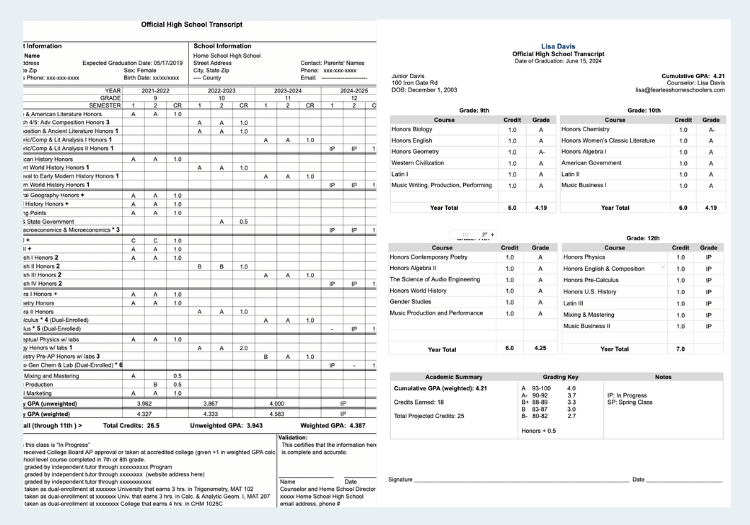
Remember This
A subject transcript not only highlights the strong subjects but also highlights the weak subjects. Yikes.
The Advantages of Yearly Transcripts
- Easily shows progression: Without a doubt, a yearly transcript easily shows your teen’s academic journey from start to finish, from course selection to rigor to GPA.
- Easier to Read: Depending on the transcript template you use, a subject transcript can look super cluttered if you’re trying to tell it all. Your job isn’t to share everything; it’s to share what colleges need to understand your teen’s progression.
- Easier to Self Report Courses and Grades: Many colleges require a student to list their courses and grades in a yearly format (yes, in addition to the transcript). If you’ve experienced this, you know it’s a bear to fill out. Your teen will need to look at their transcript to copy it into the specific format that the college requires. A yearly transcript makes this much easier on your student!!
- Easier to see 4 years of each core subject. Sounds counterintuitive, right? But when using a subject transcript, electives become an issue. Will you have them in an elective section or listed under the relevant subject, hiding those core academic classes?
- Easier to see 12th grade classes that are In Progress: Colleges want to easily see what classes are on dock for 12th grade. Again, that Upward Trend. A yearly transcript easily shows this.
What Kind of Transcript Do Colleges Want?
Each year in the Fearless Homeschoolers Facebook Group, parents tell of schools that specifically request yearly transcripts. Not a problem, of course, if that’s the way you’ve created it, but extra work if you only have a subject transcript created.
And what have I found when meeting with college admissions officers around the country? They prefer transcripts organized by year. Just recently, Colorado College reinforced this when asked. “If you do organize it by subject, please include the dates each class was taken. When a class was taken is important to the context.”
What Colleges Say
Lafayette College: “A transcript reporting all academic courses taken from 9th to 12th grades with course name, credit and grade as well as the type of instruction (online, local college, co-op, tutorial, etc). We prefer this document to list the courses in year order versus by subject matter.”
University of Dallas: “Courses organized by year. (If organized by subject, the years in which the courses were completed must be clearly noted.)
Ohio University: All applicants must provide a high school transcript that includes the following: course titles, the date range (month / year) of when each course was taken, units earned, expected graduation date; and course grades.”
The Importance of Dates (& Why Colleges Care)
I’ve seen a couple of different kinds of subject transcripts. One is laid out like a yearly transcript. The only difference is it’s organized by subject and usually not dated.
Others seem to be trying to do and be everything all at once.
No matter what kind of transcript template you use, include dates for when the class was taken.
That Colorado College rep I talked about? He stressed the importance of dates on whatever transcript template you choose. Why? It not only shows progression, but it simply demands some kind of accountability. Leaving dates off makes room for, “Well, my kid took some high school level Bio in 7th grade so let me just combine it with Bio work in 8th and 9th grade and add it to the high school transcript.”
I can’t stress this enough: College admissions officers want to know the student they’re getting - the student from the previous 3 years. And they want evidence that the student took full credit classes - from each core subject - in each of those years.
FAQ’s
How do I highlight academic strengths on a yearly transcript?
Under each particular year, list classes in order of strongest to weakest. Follow the same pattern for each year.
How do I list a semester long community college class on a yearly transcript?
If your transcript doesn’t have columns for spring/fall, just list a community college class under the appropriate year. In your course descriptions, specificy which semester it was taken.
What if a class goes longer than a year?
Either list it in the year where the bulk of learning took place or include it in the year it was finished. There’s room for flexibility here! If you feel that it needs further explanation, do that in the school profile or course descriptions.
Where do I put summer classes?
Decide what a school year is for your homeschool. For me, our year went from July to June and my summer classes went into the appropriate year.
What format do most traditional schools use?
As far as I know, subject transcripts are a uniquely homeschool thing to do. Most traditional schools organize their transcript by year.
Will my teen still get accepted to college if I choose a subject transcript?
Of course! Colleges are used to seeing lots of different kinds of transcripts. And you know what I say…there is no right or wrong; there are lots of ways of doing this. But if you’re asking my opinion when given the choice, well, you know what it is. ;)
Conclusion:
Your homeschool transcript has a job to do. To quickly and easily show your teen’s progression over the course of four years.
While a subject transcript allows for flexibility when classes last longer than a year and allows you to highlight your teen’s strongest subjects, a yearly transcript does the same. And more.
When choosing your transcript template, put yourself in the shoes of a college application reader. You’re exhausted, working through dozens of college applications a day. What transcript template would make things easier for you to understand?
One Thing to Do:
- If choosing to use a subject transcript: Include dates for each course.
- If choosing to use a yearly transcript: List in order of strongest to weakest subjects.
Question For You:
What schools have you found that require yearly transcripts?
👉 Get Your Homeschool Transcript Template HERE!
